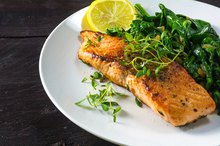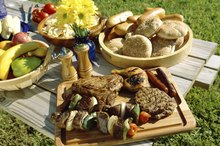Can the Food You Eat Change Your Period?
Your period, or menstrual bleeding, happens when your body sheds the lining of its uterus. Having a normal menstrual cycle, meaning you have regularly occurring periods that last three to five days with mild to moderate symptoms, is an important indication that your body is functioning well, according to the Office on Women's Health. It also indicates that you are not pregnant. Your overall diet may influence your symptoms, such as cramping, bloating, food cravings, mood swings and the heaviness of your menstrual flow.
Cold-Water Fish
Cold-water fish provides rich amounts of protein and contains less saturated fat than red and processed meats. A diet rich in fish oils and low in animal fat may help manage menorrhagia, or heavy menstrual bleeding, according to a report published in the "Journal of the Canadian Chiropractic Association" in December 2007. Fish oil may also help reduce menstrual pain and swelling related to your period. Fish particularly rich in anti-inflammatory oils include salmon, herring, albacore tuna, trout, halibut, mackerel and sardines. For heightened benefits, use low-fat cooking methods such as baking, broiling and poaching.
- Cold-water fish provides rich amounts of protein and contains less saturated fat than red and processed meats.
- For heightened benefits, use low-fat cooking methods such as baking, broiling and poaching.
Low-Fat Milk
Low-Carb Diet and the Menstrual Cycle
Learn More
Calcium-rich foods may help to reduce menstrual pain and help to regulate your periods altogether. Calcium plays an important role in your hormone levels and low calcium levels are linked with amenorrhea, according to the Office of Dietary Supplements -- a condition in which your menstrual cycle stops. Low-fat milk, both cow's milk and soy varieties, provide valuable amounts of calcium and promote hydration, which is important for maintaining positive energy levels and moods. It also may help your body flush excess fluids out through urine, reducing bloating.
- Calcium-rich foods may help to reduce menstrual pain and help to regulate your periods altogether.
Fruits and Vegetables
Fruits and vegetables are prime sources of antioxidants -- nutrients that strengthen your body's ability to defend itself from infections and disease. Changing your diet to include more antioxidant-rich varieties, such as berries, cherries, citrus fruits, tomatoes, bell peppers, broccoli, spinach and squash, may help reduce menstrual cramps, according to the University of Maryland Medical Center. Dark green leafy vegetables, such as kale, mustard greens and spinach, also provide valuable amounts of calcium. Low-sodium vegetable soup also provides ample nutrients and fluids.
- Fruits and vegetables are prime sources of antioxidants -- nutrients that strengthen your body's ability to defend itself from infections and disease.
- Dark green leafy vegetables, such as kale, mustard greens and spinach, also provide valuable amounts of calcium.
Plant-Derived Fats
How to Lose Weight During Perimenopause
Learn More
Vegetable oils, nuts, seeds, avocados and olives provide healthy, unsaturated fats and rich amounts of the antioxidant vitamin E. Increasing your vitamin E intake may help to reduce menstrual pain, according to the UMMC. Plant-derived fats also provide nutritious alternatives to saturated fat sources, such as butter, margarine and high-fat cheese, which may worsen inflammation. Because fats aid in nutrient absorption, incorporate healthy fats into nutritious meals for heightened benefits.
Whole Grains
Whole grains contain more fiber, protein and micronutrients, including B-vitamins and iron, than refined grains. Vitamin B-6 may help reduce premenstrual syndrome symptoms, according to the UMMC. Heavy menstrual bleeding is a risk factor for an iron deficiency. Whole grains are also low-glycemic, meaning they have a mild impact on your blood sugar levels and may improve your energy and moods while delaying hunger cues, making it easier to control your appetite. For best results, replace enriched breads, pasta, cereals and snack foods with whole grains, such as brown rice, oats, wild rice, barley and popcorn.
- Whole grains contain more fiber, protein and micronutrients, including B-vitamins and iron, than refined grains.
- Whole grains are also low-glycemic, meaning they have a mild impact on your blood sugar levels and may improve your energy and moods while delaying hunger cues, making it easier to control your appetite.
Related Articles
References
- "Journal of the Canadian Chiropractic Association"; Menorrhagia: A Synopsis of Management Focusing on Herbal and Nutritional Supplements, and Chiropractic; Anna B. Livdans-Forret et al; Dec. 2007
- Office of Dietary Supplements: Vitamin E Fact Sheet
- Office on Women's Health: Menstruation and the Menstrual Cycle
Writer Bio
August McLaughlin is a certified nutritionist and health writer with more than nine years of professional experience. Her work has been featured in various magazines such as "Healthy Aging," "CitySmart," "IAmThatGirl" and "ULM." She holds specializations in eating disorders, healthy weight management and sports nutrition. She is currently completing her second cookbook and Weight Limit—a series of body image/nutrition-related PSAs.









